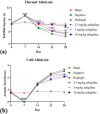Facile fabrication of selegiline-loaded alginate hydrogel for neuroprotection and functional recovery in a rat model of spinal cord injury through localized spinal delivery
- PMID: 40666188
- PMCID: PMC12258782
- DOI: 10.22038/ijbms.2025.81837.17706
Facile fabrication of selegiline-loaded alginate hydrogel for neuroprotection and functional recovery in a rat model of spinal cord injury through localized spinal delivery
Abstract
Objectives: Spinal cord injury (SCI) is a highly disabling and fatal disorder with no effective treatment to date. Selegiline, a selective MAO-B inhibitor, has shown new neuroprotective and neurorescuing effects with various beneficial effects on neuron-associated disorders. These effects have triggered investigations into its impact on different neuron-associated disorders and SCI. Thus, in continuation of the previous studies, this study evaluates the local therapeutic effects of selegiline-loaded alginate hydrogel on SCI by analyzing apoptotic factors, histological factors, and improvements in locomotor function and neuropathic pain.
Materials and methods: Hydrogels were fabricated via cross-linking gelation method and characterized by FT-IR and SEM analysis. Selegiline release from hydrogels was evaluated by UV spectroscopy, and hydrogel biocompatibilities were verified through an MTT assay. Afterward, 36 rats were divided into six groups: sham, negative group, treated with empty hydrogel, and three selegiline-treated groups (2.5, 5, and 10 mg/kg). After 28 days, the locomotor activity, the expression of Bax and Bcl2 (apoptosis index), and GFAP changes in the lesion site were assessed using Basso, Beattie, and Bresnahan (BBB) scale, western blot technique, and immunohistochemical assay, respectively.
Results: Hydrogel tests showed the suitability of hydrogels and sustained selegiline release from them. Rats treated with selegiline-loaded hydrogels showed significant locomotor improvement and reduced apoptosis indices in SCI-induced rats (P≤0.05). Additionally, GFAP immunohistochemistry analysis indicated notable histological improvements.
Conclusion: Findings suggest that selegiline-loaded hydrogels can improve SCI through apoptosis inhibition and neurorescuing effects. Further clinical studies are warranted to validate these findings in human SCI.
Keywords: Alginate hydrogel; Apoptosis; Functional recovery; Selegiline; Spinal cord Injury.
© 2025. This work is openly licensed via CC BY 4.0.
Conflict of interest statement
The authors have no financial or proprietary interests in any material discussed in this article.
Figures










References
-
- Eckert MJ, Martin MJ. Trauma: Spinal cord injury. Surg Clin North Am. 2017;97:1031–1045. - PubMed
LinkOut - more resources
Full Text Sources
Research Materials
Miscellaneous
